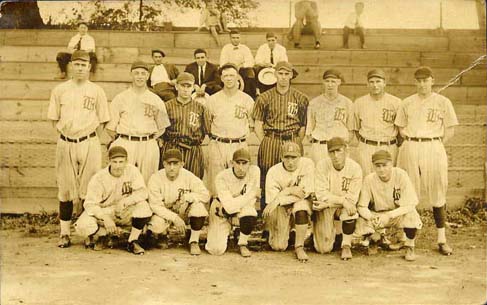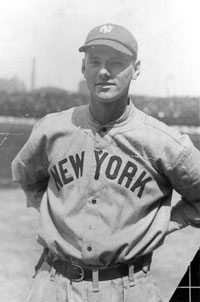|
Years the League Operated 1915
1916
1917
1918
1920
Standings and League Leaders |
Class D, Blue Ridge League
- Chapter 2
After their
success in their initial season in 1915, the Class D, Blue
Ridge League went through some growing pains in their second
season. Despite the turmoil of war,
looming greater over in Europe, which was beginning
to take a toll on the minor leagues throughout the country, the
fans of the Blue Ridge League towns continued to
support their hometown
teams
with earnest.
Nickname Changes
Several of the league clubs
decided to change their nicknames
prior to the second season. Frederick, which captured the first
Blue Ridge League pennant the year before,
decided to change their name to Champs,
taking the moniker away from Martinsburg, who had won the 1914
Tri-City League title. The West Virginia
panhandle club selected Mountaineers as
their nickname. Hagerstown, which didn't like the name Blues,
changed their nickname to Terriers, after a fan vote. Gettysburg
changed from Patriots
to Ponies, while Hanover went from Hornets to Raiders.
Change in Leadership
The league was beginning to
take shape, but it still had a
few flaws to work out. Blue Ridge League
President Charles Boyer, who also had
served previously as league president in both the South Atlantic
and Virginia State Leagues, was taking
some heat from some of his fellow counterparts,
because of a conflict of interest, since he still owned the
Hagerstown club at the same time. It was felt by
some members that the league umpires that
Boyer had hired, were showing some favoritism towards Boyer's
club, especially when they played at Willow Lane Park, Boyer's
home field. Unfortunately, the issue
became very heated among some the newspapers
that were reporting on the league. Led by the Chambersburg's
Repository and The Public Opinion, their
criticism's ultimately resulted in Boyer's
resignation as league president on May 14, after both his
honesty and integrity were questioned, as
well as an umpire named Wisner, who quit
the
day before.
The remaining league Board
of Directors voted on Boyer's
replacement, but each club selected a person
associated with each of the affiliate
league clubs. After more discussion, Martinsburg Max von
Schlegel and Frederick's Frank K. Schmidt
recommended James Vincent Jamison, Jr.. Jamison,
a well known Hagerstown businessman, was known for his unbiased
attitude and integrity, and all of the league
clubs voted unanimously to elect Jamison
as the new President of the Blue Ridge League, after just one
full week into the
1916 season.
Jamison had his work cut
out for him. The league was in
some disarray, and even though the board of
directors decided to raise each club's
monthly salary cap from $800 to $1,100 per month, their was
still some
concern over the honesty of some of the individual club's
ethics.
Challenges On The Field
Though the league as a whole was
financially secure, some of the smaller towns,
especially Gettysburg, were still struggling. The Ponies
played their games at Nixon Field on the campus of
Gettysburg College, which had no grandstand or fence,
and could not charge ticket admissions since they had
nothing to control the flow of fans coming to their
games.
The umpire situation became a challenge for Jamison during the early part of his administration, as it seemed some of the clubs and their newspapers were still voicing their opinions over the favoritism some of the umpires were showing against the clubs. Some of the clubs, especially the teams from Pennsylvania were the most vocal, both on and off the field. Hanover Manager Billy Starr, who was notorious for his "crabbing" and of protesting games, had a game forfeited against his club in Chambersburg on August 22. A controversial double play call by Umpire Marks sparked vocal protests by several Raider players, because they felt the umpire was being unfair by siding with the Maroons. After "crabbing" with Marks, the umpire tossed out several Hanover players, and had Starr chased from the field by a policeman, before announcing to the crowd that the game was forfeited to Chambersburg, 9-0. Due to the war effort overseas, the league had trouble finding good umpires, as some joined the service, or were promoted to other existing leagues. Jamison did eventually bring back some of his umpiring crew from the year before, including veteran umps Levi Glatts and "Doll Derr", to help ease the situation. Both Glatts and Derr were umpiring in the New York State League, which had disbanded.
Player Changes and
Roster Loopholes
Once in office, Jamison did
impose a limitation on the type
of players who coming into the league,
disallowing any new incoming players with
Major League experience, and limiting each club to just two
players who played on the Class B or C
levels. Unfortunately, though the idea was a good
one, there were loopholes that some of the clubs and players
took advantage of. Since there were
limited resources to verify player's status, it
was not uncommon for them to play under an alias, since the only
way to check was by their playing name.
Two known examples were Wick Winslow and Kenny
Thompson. Winslow, a veteran Class B pitcher whose real name was
Walter P. Warwick, had to change his playing name
to be eligible to play for Hagerstown,
since they already reached the league's player level limit on
their roster. Warwick's alias was penned by his
manager, Bert Weeden, in a post office in
Brockton, MA as they were leaving to go to Hagerstown for the
start of the season. Weeden noticed a sign
outside the post office that read
"Mrs. Winslow's Soothing Cough Syrup," and tagged the
name to Warwick,, adding his nickname
"Wick", to change it to "Wick Winslow."
Ironically, Winslow tossed a no-hitter for
Hagerstown, then was released mid-season, before
finishing up the last month of the season with the Frederick
club. The following season, 1917, Winslow
became the only Frederick pitcher to win 20-games
in one season, when he accounted for 21 of the Hustlers 44 wins.
Thompson, whose real name was Kenneth Knode,
played under an alias with Martinsburg in
the Blue Ridge League, in order to keep his college
eligibility. A second baseman, it was widely known by the local
newspapers that Thompson was in reality Knode,
but since he played for a college in the
midwest, he still he kept his college eligibity, since he
must of kept his alias a secret during that time.
At that time, Knode also
was
the team captain of the University of Michigan football eleven.
The Year of the Maroons
The rivalry between the two clubs became very heated in August, especially after the two teams had tied three games, including one in Martinsburg, and the Chambersburg directors refused to play in West Virginia city. President Jamison sternly informed the Chambersburg club that they had to play one of the games in Martinsburg, or lose their $400 forfeit money put up by each club at the beginning of the season. The Maroons complied.
The League's Best
The Mountaineers were led
by pitching sensation Marvin Goodwin
of Gordonsville, VA, who led the league with 19 wins and 165
strikeouts, while Frank Colley accounted for 17
victories. Alan "Lefty" Clarke
added 14 wins and 126 strikeouts for the "Eers, as
Martinsburg's Big Three accounted for 50
of their 56 victories. George "Reggie" Rawlings was
the top fielding outfielder in the league, as
well of one of the better hitters. The 'Eers
infield of Short Long, Johnny Bates, Katsey Dean, and a 19-year
old first baseman named Luzerne Blue also helped contribute to
the "Eers pennant drive. Hagerstown,
under new manager Bert Weeden, kept the Terriers in
the race most of the season, falling five games back on the last
day of the season. First baseman Jack
Hurley, and outfielder Charley Dysert were mainstays
in the Hagerstown battery, while "Chalkey" McCleary
had the best winning percentage in the
league (.667), winning 18, and losing only eight
game.
Other players who made
their mark during the season included
Hanover's Willie Scherdel. The 19-year old from
McSherrystown, PA, led the Raiders with a
record of 14-9, striking out 144 batters before being sold to
the Milwaukee Brewers of the American Association
with three weeks left in the season.
Frederick's Bobbie Orrison, the league's top hitter in 1915,
continued to hammer opposing pitching, tying with
teammate Clyde Barnhart for the lead
league in home runs with nine. Along with Tex Myers, the Champs
had three of the top four hitters in the league, but did not
enjoy the winning success they had the
year before as the Hustlers. Gettysburg catcher
Art Kohler of Sibleyville, IL had the eye of several Major
League scouts, because of his strong arm
and bat, and his contract was eventually
sold
to the Detroit Tigers.
The Orioles Connection
The Baltimore Orioles
played an pre-season exhibition
against Frederick at Agricultural Park, with the
Champs winning the game, 6-5. Former
Frederick player, Bill Lamar, played centerfield for the Orioles,
while Dunn's son, Jack, Jr., played centerfield for Frederick.
The younger Dunn played briefly for
Frederick, before being released a month
into
the season.

1916 Hagerstown Terriers
Class D, Blue Ridge League
From left to
right: (bottom row) Les Bangs; Bill Phoenix; Monk Walter; John
Doherty; Bill Dempsey; Walter "Polly" Speraw; (top row) Jack
Hurley; Charley Dysert; Joe Benson; Bert Weeden, Manager; Earl
N. Howard; Joe Benson; Wick Winslow; Chalkey McCleary. Photo
credits - Dan Yaw of Tampa, FL/www.vintageball.com. Picture
reproduced in Hagerstown Morning Herald on January 12, 1956.
Hagerstown Club is Sold
On August 15, former league
president Charles Boyer sold his stake
in Hagerstown's minor league baseball team to a
Stock Company headed by Colonel J. C.
Roulette, and dissolved his financial interest in the Blue
Ridge League
completely.
Challenges Off the Field
As the season progressed,
the war in Europe raged on, causing some
concern among the Blue Ridge League cities. Fan
interest started to wane late in the
summer, compared to the year before, as other more important
issues started to take the attention of the
baseball fans those communities. A country
wide service draft was looming in the distance, and some noted
baseball players began exchanging their bats and
balls for guns and bullets by enlisting in
the armed services. The Blue Ridge League, itself, was indirectly
affected by the "bigger picture of war" that was
slowly drawing the country into its
clutches. Fortunately, the game of baseball became an outlet
for many fans who wanted escape for a few hours from the
realities that
surrounded them.
Despite the growing pains,
the Class D, Blue Ridge League
continued to be an overall success in their
second year. They were one of a few of the
lower level leagues that were thriving amidst the financial
turmoil that many of the minor leagues were
facing at the time.
+++++++++++++++++++
End Chapter Two
Newspaper clippings credited to
www.newspaperarchives.com and
|
© Boys of the Blue Ridge, 2026.
Website Hosting by 270net Technologies in Frederick, Maryland

